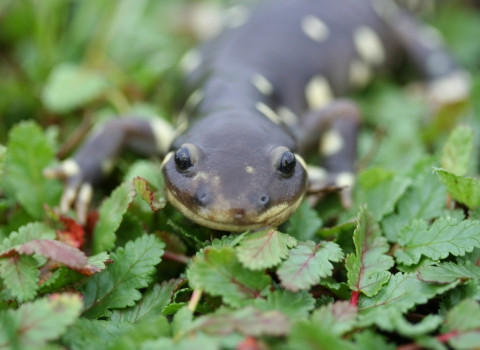SANTA FE, NM — The New Mexico Department of Game & Fish is officially on board as a lead agency in Mexican wolf recovery efforts. At a signing ceremony on Wednesday, November 6, Joanna Prukop, Chair of the New Mexico State Game Commission, and Mike Sloane, Director of the New Mexico Department of Game & Fish, signed a formal Memorandum of Understanding (MOU) with the U.S. Fish and Wildlife Service. The MOU establishes a framework for collaboration that enables the signatory agencies to implement a long-term, scientifically based program to reintroduce and manage Mexican wolves (Canis lupus baileyi) in Arizona and New Mexico to contribute toward the recovery of this endangered subspecies, in accordance with the Mexican Wolf Recovery Plan, First Revision (Recovery Plan).
“This Memorandum of Understanding is an important step toward strengthening our partnership with the U.S. Fish and Wildlife Service and the recovery of the Mexican gray wolf,” said Prukop. “Our Department’s mission is to conserve wildlife for future generations. Ensuring that native species are not only successfully reintroduced but also thrive in their native habitats is a critical part of that mission. We are very proud to join our state, local, tribal and federal partners in this program.”
By becoming a cooperating agency in the Mexican Wolf Recovery Program, the New Mexico Department of Game & Fish (Department) will once again play a significant role in the management of New Mexico’s wild population of wolves. They will join the U.S. Fish and Wildlife Service (Service), Arizona Game and Fish Department, White Mountain Apache Tribe, USDA Forest Service, USDA Animal and Plant Health Inspection Service – Wildlife Services, U.S. Bureau of Land Management, U.S. National Park Service and several participating counties in approving and carrying out wolf management activities in the Southwest.
“We all share the same goal with this program, which is to achieve recovery and turn management of Mexican wolves over to the states and tribes,” said Amy Lueders, Regional Director for the U.S. Fish and Wildlife Service in Albuquerque. “This is a program built on strong partnerships and trust. We are excited to have New Mexico Department of Game & Fish as a cooperating partner and look forward to the expertise and support they bring to the table.”
The New Mexico Department of Game & Fish plans to play a significant role in Mexican wolf management activities throughout the coming year. In January, the Department will participate in the annual Mexican wolf year-end population survey, which concludes with an aerial count and capture event. The count is a labor-intensive, multi-step event that the Service, along with tribal and state partners, conducts every year to monitor the progress of Mexican wolf recovery in the Southwest.
Come Spring, the Department will participate in cross-fostering events. Last year, five Mexican wolf pups were placed into wild dens in Arizona and seven pups were placed into wild dens in New Mexico, in accordance with the Mexican Wolf Recovery Plan. Cross-fostering is a proven way to introduce captive-born pups into the litter of an experienced wild female. In 2020, the plan is to cross-foster as many pups as logistically feasible into the wild.
The Department also plans to put staff on the ground to work with local communities and address conflicts across the landscape. Reducing conflict with livestock remains a primary management focus for all cooperators.
“We look forward to working closely with the Service to find real tangible ways to mitigate impacts on livestock producers,” said Prukop. “We have to make this program work for everyone.”
The Mexican wolf is the rarest subspecies of gray wolf in North America. It is listed as endangered under the federal Endangered Species Act. Once common throughout portions of the southwestern United States and Mexico, it was all but eliminated from the wild by the 1970s.
Working with the Mexican government, the Service in 1977 initiated development of a captive breeding program to save the Mexican wolf from extinction. It started with seven wolves, aiming for the day the program could release wolves into the wild. That day came in 1998, when the Service released 11 wolves within a range called the Mexican Wolf Experimental Population Area in Arizona and New Mexico.
In November 2017, the Service completed the Mexican Wolf Recovery Plan, First Revision. The recovery plan uses the best available science to chart a path forward for the Mexican wolf that can be accommodated within the species’ historical range in the Southwestern United States and Mexico. This revised plan provides measurable and objective criteria for successful recovery. If those goals are met, the Service will be able to remove the Mexican wolf from the list of endangered species. The wolf’s management would be turned over to the appropriate states and Native American tribes.
At the end of 2018, surveys counted a minimum of 131 Mexican wolves in the wild in Arizona and New Mexico. In addition, approximately 280 additional wolves are being held in various captive-breeding facilities located throughout the United States and Mexico.
For more on the Mexican Wolf Recovery Program, visit the Mexican Wolf website (www.fws.gov/southwest/es/mexicanwolf).
The U.S. Fish and Wildlife Service works with others to conserve, protect and enhance fish, wildlife, plants and their habitats for the continuing benefit of the American people. For more information on our work and the people who make it happen, visit http://www.fws.gov/. Connect with our Facebook page, follow our tweets, watch our YouTube Channel and download photos from our Flickr page.
It is the mission of the New Mexico Department of Game and Fish to “conserve, regulate, propagate and protect the wildlife and fish within the state of New Mexico.” For more information on the Department, visit http://www.wildlife.state.nm.us/ or check us out on Facebook, Instagram, Twitter and YouTube.
###


